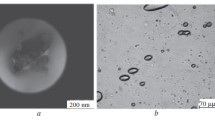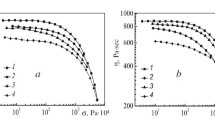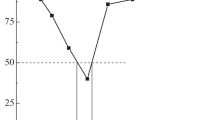Abstract
Mixtures of cellulose and chitosan have been obtained under shear deformation conditions using different types of equipment. The presence of an intense interaction between chitosan and cellulose has been revealed. On the basis of IR spectroscopy, a conclusion was drawn that there were qualitative changes in the system of hydrogen bonds between cellulose hydroxyl groups and chitosan amino groups, which indicated mixing of polysaccharides on the molecular level. The possibility of obtaining cellulose–chitosan mixtures in the presence of alkali under shear deformation conditions has been demonstrated.





Similar content being viewed by others
REFERENCES
B. Jia, I. Mei, L. Cheng, et al., “Preparation of copper nanoparticles coated cellulose films with antibacterial properties through one-step reduction,” ACS Appl. Mater. Interfaces 4 (6), 2897–2902 (2012).
L. Dai, R. Liu, L.-Q. Hu, and C.-L. Si, “Simple and green fabrication of AgCl/Ag-cellulose paper with antibacterial and photocatalytic activity,” Carbohydr. Polym. 174, 450–455 (2017).
A. Barbiroli, F. Bonomi, G. Carpetti, et al., “Antimicrobial activity of lysozyme and lactoferrin incorporated in cellulose-based food packaging,” Food Control 26 (2), 387–392 (2012).
S. S. Abkenar and R. M. A. Malek, “Preparation, characterization, and antimicrobial property of cotton cellulose fabric grafted with poly (propylene imine) dendrimer,” Cellulose 19 (5), 1701–1714 (2012).
Y. Wu, X. Luo, W. Li, et al., “Green and biodegradable composite films with novel antimicrobial performance based on cellulose,” Food Chem. 197, 250–256 (2016).
M. D. Teli and J. Sheikh, “Antibacterial and acid and cationic dyeable bamboo cellulose (rayon) fabric on grafting,” Carbohydr. Res. 88 (4), 1281–1287 (2012).
E. A. Akopyan, A. Yu. Karmilov, V. G. Nikol’skii, A. M. Khachatryan, and N. S. Enikolopyan, “Elastic-deformation shredding of thermoplastics,” Dokl. Akad. Nauk SSSR 291 (1), 133–136 (1986).
N. S. Enikolopian, “Some aspects of chemistry and physics of plastic flow,” Pure Appl. Chem. 57 (11), 1707–1711 (1985).
S. Z. Rogovina, K. V. Aleksanyan, L. V. Kompaniets, and E. V. Prut, “Obtaining and studying the properties of biodegradable mixtures based on synthetic and natural polymers,” Vse Mater., Entsikl. Sprav., No. 8, 28–34 (2009).
S. Z. Rogovina, K. V. Aleksanyan, and E. V. Prut, “Biodegradable mixtures of chitin and chitosan with synthetic polymers,” Vse Mater., Entsikl. Sprav., No. 7, 16–20 (2011).
ACKNOWLEDGMENTS
This work was financially supported by the Ministry of Education and Science of the Russian Federation, state order no. 10.1718.2017/PCh.
Author information
Authors and Affiliations
Corresponding author
Additional information
Translated by D. Marinin
Rights and permissions
About this article
Cite this article
Rogovina, S.Z., Deberdeev, R.Y. & Fadeeva, K.S. Composites Based on Cellulose and Chitosan. Polym. Sci. Ser. D 11, 448–453 (2018). https://doi.org/10.1134/S1995421218040196
Received:
Published:
Issue Date:
DOI: https://doi.org/10.1134/S1995421218040196




